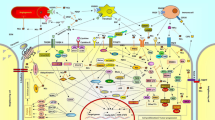Abstract
The marine-derived cembranoid sarcophine (1) and its sulfur-containing semisynthetic derivatives (2–6) were evaluated for anticancer potential using cell cycle progression markers. No effect on MCF-7 cell viability or apoptosis was seen with these derivatives at concentrations of up to 100 μM after 72 h of incubation. At 100 μM, sarcophine and its derivatives 2–5 arrested the MCF-7 cells in G0/G1 phase, with concomitant decrease in the cell populations at S and G2+M phases. MDA-MB-231 cells were not responsive to any of the derivatives. Our preliminary results suggest that the sulfur-containing derivatives of sarcophine, especially 2 and 3, show potent and cell-specific antiproliferative activity.



Similar content being viewed by others
References
El Sayed KA, Hamann MT, Waddling CA, Jensen C, Lee SK, Dunstan CA, Pezzuto JM (1998) Structurally novel bioconversion products of the marine natural product sarcophine effectively inhibit JB6 cell transformation. J Org Chem 63(21):7449–7455
Sawant SS, Sylvester PW, Avery MA, Desai P, Youssef DTA, El Sayed KA (2004) Bioactive rearranged and halogenated semisynthetic derivatives of the marine natural product sarcophine. J Nat Prod 67(12):2017–2023
Sawant SS, Sylvester PW, Arant ME, Mayer AMS, Youssef DTA, El Sayed KA (2006) Anticancer and anti-inflammatory sulfur-containing semisynthetic derivatives of sarcophine. Chem Pharm Bull 54(8):1119–1123
Sharghi H, Ali Nasseri M, Niknam K (2001) Phenol-containing macrocyclic diamides as new catalysts in the highly regioselective conversion of epoxides to beta-hydroxy thiocyanates. J Org Chem 66(22):7287–7293
Tamami B, Mahdavi H (2002) Synthesis of thiocyanohydrins from epoxides using quaternized amino functionalized cross-linked polyacrylamide as a new solid–liquid phase-transfer catalyst. Tetrahedron Lett 43(35):6225–6228
Yadav JS, Reddy BVS, Reddy CS (2004) Selectfluor: a novel and efficient reagent for the synthesis of β-hydroxy thiocyanates. Tetrahedron Lett 45(6):1291–1293
Jesberger M, Davis TP, Barner L (2003) Applications of Lawesson’s reagent in organic and organometallic syntheses. Synthesis 13:1929–1958
Shabana R, Osman FH, Atrees SS (1994) Organophosphorus compounds. XV. The reaction of 2,4-bis(4-methoxyphenyl)-1,3,2,4-dithiadiphosphetane 2,4-disulfide (Lawesson’s reagent) with aromatic dihydroxy compounds. Simple new route to 1,3,2-dioxaphospholane 2-sulfide. Tetrahedron 50(23):6975–6988
Nishio T (1989) A novel transformation of alcohols to thiols. Chem Commun 4:205–206
El-Barbary AA (1984) Reaction of esters, ortho esters, acetals, thioacetals and epoxides with 2,4-bis(4-methoxyphenyl)-1,3,2,4-dithiadiphosphetane 2,4-disulfide (Lawesson reagent). Monatsh Chem 115(6–7):769–777
Arif JM, Kunhi M, Siddiqui YM, El Sayed KA, Orabi KY, Al-Hazzani A, Al-Ahdal MN, Al-Khodairy FM (2004) Role of intermediary biomarkers in determining the anticancer efficacy of marine compounds. Med Chem Res 13(6–7):553–562
Arif JM, Kunhi M, Siddiqui YM, El Sayed KA, Orabi KY, Al-Hazzani A, Al-Ahdal MN, Al-Khodairy FM (2004) Differential modulation of benzo[a]pyrene-derived DNA adducts in MCF-7 cells by marine compounds. Int J Cancer Prev 1:259–268
Satyanarayana C, Deevi Dhanavanthri S, Rajagopalan R, Srinivas N, Rajagopal S (2004) DRF 3188 a novel semi-synthetic analog of andrographolide: cellular response to MCF 7 breast cancer cells. BMC Cancer 4:26–33
Kuo P-L, Hsu Y-L, Lin T-C, Lin L-T, Chang J-K, Lin C-C (2005) Casuarinin from the bark of Terminalia arjuna induces apoptosis and cell cycle arrest in human breast adenocarcinoma MCF-7 cells. Planta Med 71(3):237–243
Tabruyn SP, Nguyen N-Q-N, Cornet AM, Martial JA, Struman I (2005) The antiangiogenic factor, 16-kDa human prolactin, induces endothelial cell cycle arrest by acting at both the G0-G1 and the G2-M phases. Mol Endocrinol 19(7):1932–1942
Varshochi R, Halim F, Sunters A, Alao JP, Madureira PA, Hart SM, Ali S, Vigushin DM, Coombes RC, Lam EWF (2005) ICI182,780 induces p21Waf1 gene transcription through releasing histone deacetylase 1 and estrogen receptor alpha from Sp1 sites to induce cell cycle arrest in MCF-7 breast cancer cell line. J Biol Chem 280(5):3185–3196
El-Deiry WS, Harper JW, O’Connor PM, Velculescu VE, Canman CE, Jackman J, Pietenpol JA, Burrell M, Hill DE, Wang Y et al (1994) WAF1/CIP1 is induced in p53-mediated G1 arrest and apoptosis. Cancer Res 54(5):1169–1174
Bernstein J, Shmeuli U, Zadock E, Kashman Y, Neeman I (1974) Sarcophine, a new epoxy cembranolide from marine origin. Tetrahedron 30(16):2817–2824
Krishan A (1975) Rapid flow cytofluorometric analysis of mammalian cell cycle by propidium iodide staining. J Cell Biol 66(1):188–193
Acknowledgments
The authors are thankful to Dr. Khaled Y. Orabi, Kuwait University, Kuwait, for help in the procurement of the marine compounds. Dr. R. A. Hill, Dr. A. M. Crider, and Dr. M. E. Arant are acknowledged for their valuable discussions. This publication was made possible by NIH grant no. P20 PR16456 from the BRIN Program of the National Center for Research Resources. Philip Morris USA Inc., Richmond, VA, is also acknowledged for financial support.
Author information
Authors and Affiliations
Corresponding authors
Rights and permissions
About this article
Cite this article
Arif, J.M., Sawant, S.S., El Sayed, K.A. et al. Antiproliferative potential of sarcophine and its semisynthetic sulfur-containing derivatives against human mammary carcinoma cell lines. J Nat Med 61, 154–158 (2007). https://doi.org/10.1007/s11418-006-0113-8
Received:
Accepted:
Published:
Issue Date:
DOI: https://doi.org/10.1007/s11418-006-0113-8




